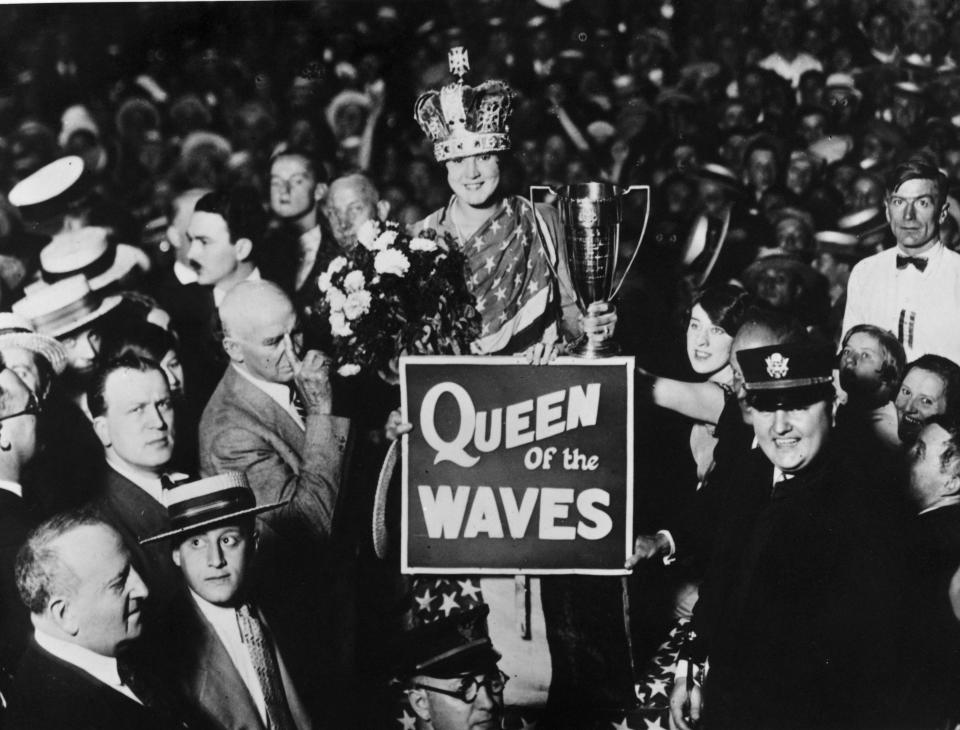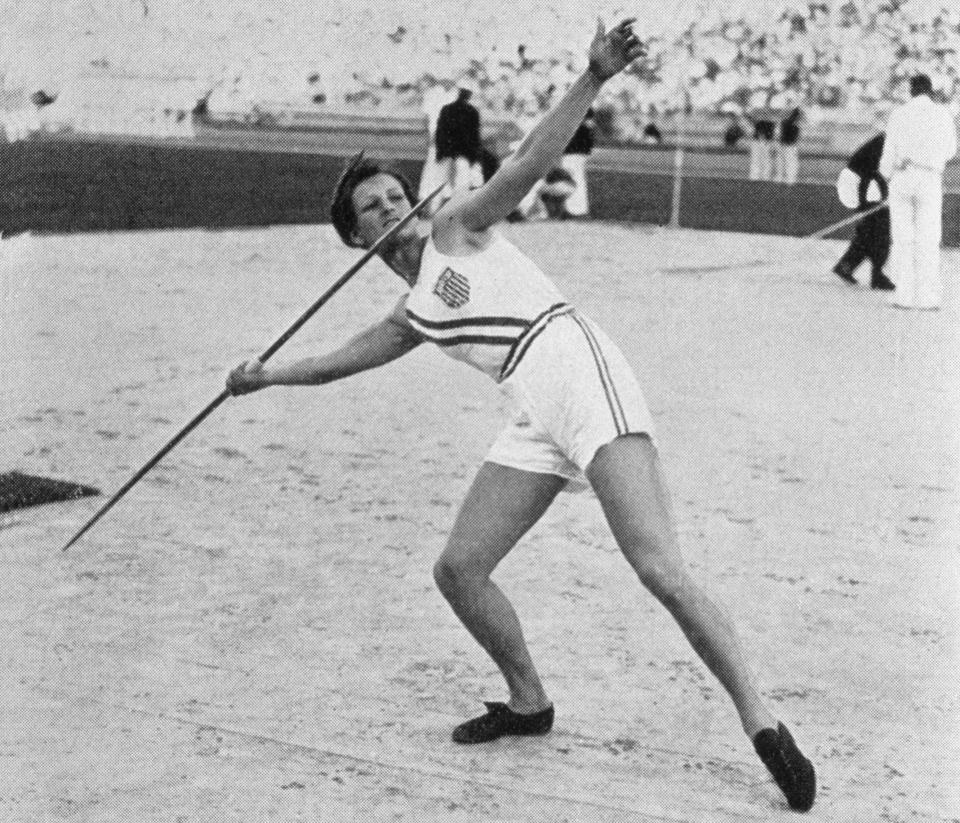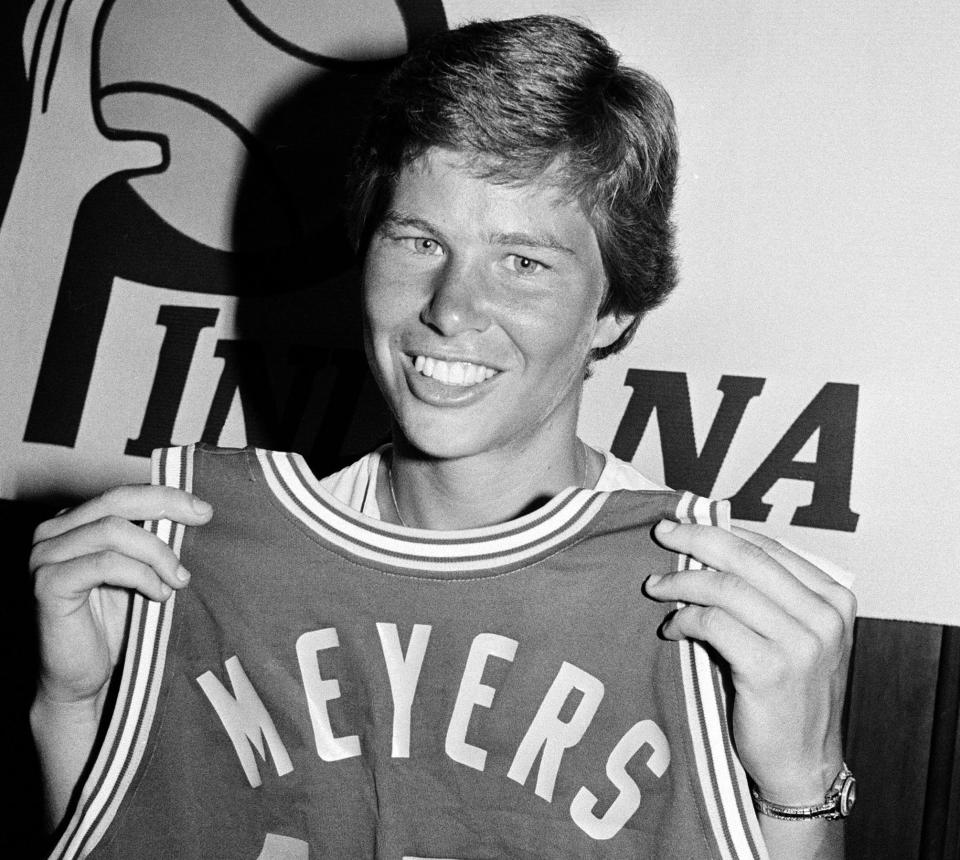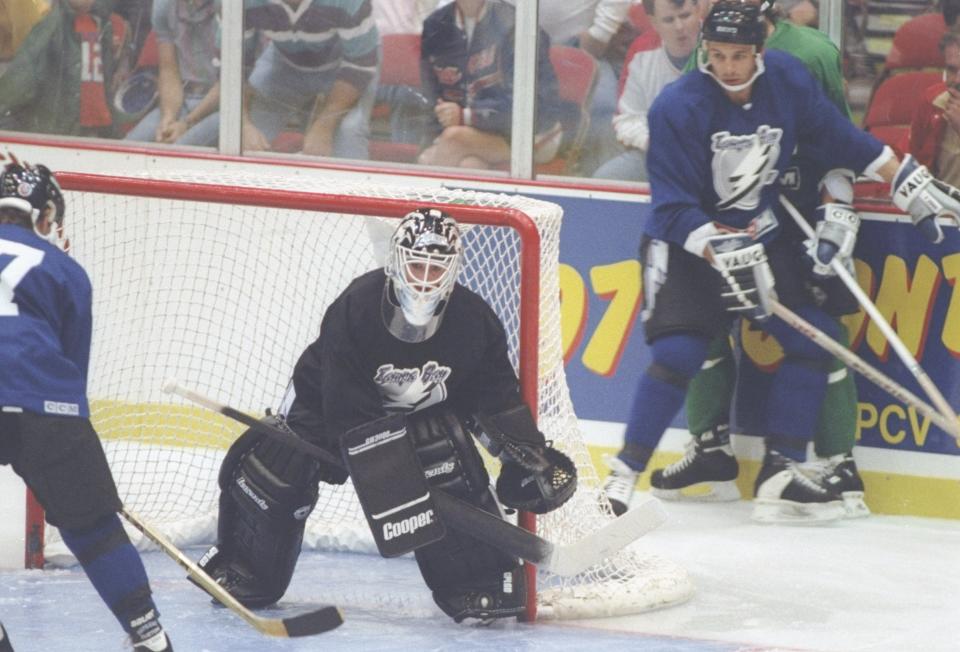Know Your Herstory: 10 sports pioneers to celebrate for Women's History Month

Millions of women and girls participate in sports today, from Little League and Pee-Wee all the way up to the pros. They walked through the doors that had been forced open by the trailblazers and pioneers who came before them. Less than 100 years ago, women weren’t just fighting for inclusion, they were fighting for the basic recognition that women can be elite athletes.
These 10 women used their talent as a battering ram to break barriers and shatter expectations. Their accomplishments forced society to question their preconceived notions of how women should look, act, and do with their lives. These women helped to pave the road that millions would walk on, and they should not be forgotten for their contribution to elite athletics, or for the sacrifices that led them there.
Gertrude Ederle (swim)
In 1926, Gertrude Ederle rocketed to fame when she became the first woman to swim the English Channel. A swimmer since shortly after she was born in 1905, she continued to swim even after doctors warned her that doing so would worsen her hearing, which had been damaged by a childhood bout of the measles.
Ederle, who at one point held 29 amateur national and world records at various freestyle distances, competed at the 1924 Summer Olympics in Paris before she attempted her Channel swim. She won gold in the 400-meter freestyle relay and two bronze medals in the 100 and 400 freestyle.
Two years later, she successfully swam the English Channel. Coated in sheep grease to prevent chafing, she entered the water on Aug. 6, 1926 with the sea rough and choppy. When the water is calm, the Channel swim is 21 miles. When it’s rough, it’s much more. Ederle had to swim at least 35 miles to traverse the Channel that day, and she did it in 14 hours and 31 minutes. That was a world record at the time, at least two hours faster than any of the five men who completed the swim before her.

When news of Ederle’s accomplishment spread, she was an instant celebrity. She was given ticker-tape parades and received massive waves of fan mail and numerous marriage proposals. She joined a touring vaudeville act and participated in a 10-minute movie about her life. But the attention was draining, and a few years after her Channel swim she had a nervous breakdown.
Ederle was also going deaf. The hearing problem she’d developed at age 5 hadn’t abated, and the Channel swim made the problem considerably worse. She began to retreat from public life and from people in general. Even though she never learned sign language, she taught swimming at the Lexington School for the Deaf for many years by physically demonstrating to her students what they should be doing while in the water.
Ederle never married and lived in Flushing, Queens, until her death in 2003 at age 98.
Babe Didrikson Zaharias (multisport)
Not even the great Bo Jackson can live up to what Babe Didrikson (later Babe Didrikson Zaharias) accomplished in her 45 years on this earth. Didrikson, born in 1911, was a pioneer in women’s sports, setting multiple world records, winning two Olympic gold medals in track and field, taking the world of women’s golf by storm, and helping to found the LPGA.
From a young age, she showed aptitude in basketball, baseball, swimming, diving, golf, volleyball, bowling, track, and even more. But everything changed in 1930 when she saw her first track meet. She competed for Employers Casualty Company at the 1932 American Athletic Union championships, which doubled as the Olympic trials. She was the only representative for her company while others brought teams of 20-plus competitors.
In three hours Didrikson competed in eight events, sometimes with only minutes in between, and singlehandedly beat every other team with 30 total points — eight more than the 22-person second place team. She placed first in five events, tied in a sixth, and set four world records.
Didrikson then took on the 1932 Olympics. She set a world record in the 80-meter hurdles and took home the gold, and got a second one when she broke the Olympic record in javelin. She got a silver in long jump, having been denied the gold due to a dubious ruling on her jumping technique.

Didrikson had immense fame following her Olympic triumph, but she was ridiculed for being too masculine. That’s partially why she took up golf, which presented female athletes in a more societally acceptable way. She got a makeover, which her new husband, wrestler George Zaharias, helped sell to the media.
Her transition to golf was necessary for another reason: as a woman, she had virtually nowhere else to compete. Golf didn’t come naturally to Didrikson, and she practiced until her hands were blistered in bleeding. It paid off. She won 82 total tournaments in her career, at one point winning 14 in a row. In 1950 she changed golf forever as one of the 13 founding members of the LPGA, and would go on to win three US Women’s Opens and 10 total LPGA tournaments.
A diagnosis of colon cancer in 1953 required her to stop all athletic activity, and doctors said she’d never golf again. Didrikson refused to let them be right. One month after having surgery and wearing a colostomy bag, Didrikson won the 1954 US Women’s Open. She dedicated it to the many cancer patients who had written to her, and became one of the first athletes to publicly crusade against cancer.
But the cancer had spread to her lymph nodes, which made it inoperable. She had to stop golfing when pain in her spine made it too difficult, and she died in 1956 at just 45. She remains America’s greatest multi-sport athlete, and many of her medals and personal effects are on display at the museum that bears her name in her hometown of Beaumont, Texas.
Alice Coachman (track & field)
Alice Coachman overcame a poor childhood to stake out a place in history. In 1948, Coachman became the first African American woman to win an Olympic medal. It was a long way from her hometown of Albany, Georgia, where she was born in 1923 as one of 10 children. She was not allowed to practice on the same field as whites so she trained in bare feet on dirt tracks, turning ropes and sticks into high jumps.
Coachman’s father would whip her for pursuing athletics instead of more feminine activities, but an aunt and a teacher encouraged her to stick with sports. It paid off when the Tuskegee Institute noticed her aptitude in high school. From 1939 to 1948 she was wildly successful, winning the Amateur Athletic Union high jump championship 10 straight times and the 50-yard dash title five straight times.

When the Summer Olympics finally took place in 1948 following World War II, she was more than ready. Competing in the high jump, she cleared 5 feet 6 1/8 inches on her first try. One other competitor matched her, but she had failed to clear at lower heights and the gold was awarded to Coachman. She was the only American woman to win gold in track and field at the 1948 Games.
Coachman’s story is one of triumph, but it’s also bittersweet. She won her Olympic gold medal at age 24, and then her athletic career ended. The 1940 and 1944 Summer Olympics were cancelled due to WWII, which robbed Coachman of two chances to compete when she was younger. The technology of the time further denied Coachman of the fame and notoriety she should have had. The Summer Olympics weren’t nationally televised until 1960, and Coachman was resentful in her later years of the fame three-time gold medalist Wilma Rudolph achieved through television during the 1960 Olympics.
Coachman became an elementary teacher, married twice, and raised two children. She created the Alice Coachman Track and Field Foundation to provide financial assistance to young athletes and former competitors, and was inducted into the U.S. Olympic Hall of Fame. She died at 90 in 2014 following a stroke and a heart attack.
Althea Gibson (tennis)
Althea Gibson was the first African American athlete to win a Grand Slam title, paving the way for the likes of Serena Williams, Venus Williams, Sloane Stephens, and Coco Gauff. She was a pioneer, breaking color lines and winning 11 Grand Slam titles in a career that didn’t take off until she was nearly 30.
Gibson, who was born in 1927, despised going to school but adored playing sports. She liked basketball but excelled at tennis, and after she quit high school she began competing in American Tennis Association tournaments, moving to North Carolina to train and finish her education in 1946.
Gibson felt she was good enough to be admitted to the all-white U.S. Nationals in 1950, but she was almost locked out — and might have been if tennis player Alice Marble hadn’t advocated for her inclusion in a public letter. Gibson nearly won the entire tournament that year, but a sudden rainstorm scuttled her chances. After that, it took years for her to get fully used to the higher level of competition and break through.
She finally did in 1956 at age 29. She won the French Championships in singles and doubles, becoming the first African American athlete to win a Grand Slam.

Gibson ruled tennis in 1957. She won Wimbledon, became the first African American woman to win U.S. Nationals, and brought home Grand Slam titles in women’s and mixed doubles. In 1958 she had even more success. She defended her Wimbledon and National titles and was the No. 1 ranked women’s tennis player in the world.
Gibson turned pro in 1958, but found it hard to earn a living since there was no professional tennis tour at that time. She tried golf but didn’t excel, failed to mount a comeback once the Open Era began in 1968, and then began teaching as a tennis pro. She suffered a stroke in the early 1990s, but survived and lived another decade until she died of a heart attack in 2003. The US Open unveiled a grand statue in her honor at Flushing Meadows at the 2019 tournament.
Wilma Rudolph (track)
Wilma Rudolph, once dubbed “the fastest woman in the world,” made history in 1960 when she became the first woman to win three gold medals in one Olympics. Such accomplishments were unthinkable for young Wilma, who was just 4.5 pounds when she was born prematurely in 1940. She was a sickly child who was homeschooled due to constant illness and had to wear braces on her legs for three years after a bout with polio.
Rudolph overcame all of that and thrived as an athlete. When she was 14 and still in high school, she was recruited to join the Tennessee State track team. Rudolph was a natural sprinter and once won all nine events she entered at an American Athletic Union track meet. At just 16 she won a bronze medal in the 4x100 relay at the 1956 Summer Olympics, and she enrolled at TSU in 1958.
At the 1960 Summer Olympics in Rome, the gifted sprinter made history. She ran three events — the 100- and 200-meter sprints, and the 4x100 meter relay — and won a gold in each one. She was the first American woman to take home three gold medals at the same Olympics. Rudolph, who loved the unity and teamwork of relay races, set a record with her teammates in the semifinals of the 4x100 relay, broke an Olympic record in the 200, and tied a world record in the 100.

Rudolph became a worldwide sensation after her history-making Olympics, touring the globe and visiting literal mobs of adoring fans, and she took her position as a role model in the black community very seriously. Rudolph’s welcome home banquet and parade were the first integrated events in her Tennessee hometown after she told the segregationist governor that she wouldn’t attend segregated events.
Rudolph married, had four children, and later served as a track coach at DePauw University. She inspired a generation of black female athletes and was often asked for advice by athletes like Jackie Joyner-Kersee and Florence Griffith Joyner. Rudolph gave it gladly. She was only 54 when she died of brain cancer in 1994 and left a legacy through not only her athletic achievements but also her kindness and humanity.
Toni Stone (baseball)
In 1953, Toni Stone became the first woman to play professional baseball when she suited up for the Indianapolis Clowns of the Negro American League. Born in 1921 and playing on all-male semipro teams by the time she was 16, she resisted the disapproval of her husband and even her teammates and tried to sustain a career in the sport she loved.
Stone moved from her native Minnesota to the Bay Area in 1946 and began playing for local barnstorming teams. She married a man who did not want her to play baseball, but she couldn’t stay away from the game. Since she couldn’t play in the segregated All-American Girls Professional Baseball League, she caught on as special attraction the Negro American League.

When the Indianapolis Clowns signed Stone to a contract in 1953, she became the first woman to play professional baseball with men. Her teammates and family were not supportive, and she would endure ridicule from fellow players even while sitting on the bench. She told the San Francisco Chronicle in 1991 that “it was hell.” She once confided to a friendly teammate that like many women of the time, she chafed at society’s expectations of her gender.
“A woman has her dreams, too,” she said, via the San Francisco Chronicle. “When you finish high school, they tell a boy to go out and see the world. What do they tell a girl? They tell her to go next door and marry the boy that their families picked out for her. It wasn’t right. A woman can do many things.”
Stone’s contract was sold to the Kansas City Monarchs after the 1953 season, and she retired from baseball in 1954 due to lack of playing time. She returned to the Bay Area to take care of her ailing husband and became a nurse. She died in 1996 at age 75, and until her death, she loved telling the story about how she once got a hit off of the legendary Satchel Paige.
Ann Meyers Drysdale (basketball)
Ann Meyers, later Ann Meyers Drysdale, was a true trailblazer for women in basketball. In 1974, Meyers was the first high school student of either gender to be part of the U.S. national basketball team. That same year, she became the first woman to be awarded a four-year athletic scholarship when she attended UCLA.
Meyers distinguished herself at UCLA. She was an All-American women’s basketball player four times, the first woman to accomplish that feat, and would later be the first woman named to the UCLA Athletics Hall of Fame. She was the first player, man or woman, in the history of Division I to pull off a quadruple-double. She won a silver medal with the rest of the U.S. women’s team in 1976, while she was still in college.

In 1979, while she was preparing to start training for the 1980 Summer Olympics, Meyers was offered the chance to try out for the Indiana Pacers, as well as a $50,000 personal services contract. Taking that chance and signing the contract would mean turning professional and giving up on her quest for Olympic gold, but she decided to do it. She was just the second woman ever to sign with an NBA team.
It was a disappointing experience. Meyers had spent months training, but her prospective teammates had to be convinced to really play with her. They eventually did, and Meyers felt she played well, but the Pacers cut her. She was gutted.
What Meyers did after her landmark Pacers contract is just as important as what she did before it. Despite the disappointing end, the tryout opened countless doors for her. She became a broadcaster at a time when there were few women doing that job, and has been part of NBC’s Olympic women’s basketball coverage since 2000. She served as general manager of the Phoenix Mercury from 2007-2011, and in 2012 she joined the Phoenix Suns broadcast team. Meyers has been enshrined in the Basketball Hall of Fame and the Women’s Basketball Hall of Fame.
Debi Thomas (figure skating)
In a sport that highly values traditional femininity and whiteness, Debi Thomas is a trailblazer. She’s the most successful African American figure skater of all time, winning two national championships and one world championship. She was the first African American to win any medal at the Winter Olympics when she took the bronze in 1988, during which she was simultaneously studying premed at Stanford.
Thomas was seen as the only skater who could beat the talented Katerina Witt at the 1988 Winter Olympics. They both skated to music from Bizet’s opera “Carmen,” and their rivalry at the Olympics was known as the Battle of the Carmens. Thomas was in first place before the long program, but she stumbled on the second of two three-spin jumps placed right at the beginning of her routine. That mistake immediately doomed her chance for gold, and while she took home the bronze, she was never able to forget that mistake.

Thomas, who had gotten three nose jobs to visually fit in with white skaters and trained to make her powerful style appear more feminine, retired from skating after the Winter Olympics and returned to Stanford. She graduated in 1991, went to medical school, and became an orthopedic surgeon. She was inducted into the U.S. Figure Skating Hall of Fame in 2000 and told ABC Sports that she was still disappointed about her Olympic long program.
Thomas’s self-described “Olympic mentality” made her difficult to work with, and she had employment problems. In 2010, she left her husband and teenage son to start a private practice in the economically depressed town of Richlands, Virginia, and soon fell behind on bills. She lost her practice and her medical license lapsed.
The court diagnosed her with bipolar disorder after she threatened to hurt herself in 2012, but she resisted the diagnosis. As of 2016 she was not receiving treatment and living with her fiancé and his two sons in a trailer in Richlands. All her medals, including her Olympic bronze, have been seized by the bank.
Manon Rhéaume (ice hockey)
In 1992, 20-year-old Manon Rhéaume broke new ground for women in sports. In September of that year, Rhéaume became the first woman to play for any of the four major North American sports leagues. She suited up for a Tampa Bay Lightning exhibition game, spending one period tending net as a goalie.
That was an important first for Rhéaume, and for female athletes, but that was far from her first trailblazing accomplishment. In 1984, the Quebec native became the first female goaltender for a boys’ team at the Quebec International Pee-Wee Hockey Tournament. Just before she played for the Lightning, she was the first woman to play in a men’s Major Junior hockey tournament.
Rhéaume didn’t make the team after her appearance in 1992, nor did she a year later when she played in another exhibition game for the Lightning. Between those two games, she became the first woman to play in a regular-season professional game when she appeared for the Atlanta Knights of the International Hockey League.

With no professional women’s hockey league, Rhéaume played whenever she could for the next five years. She retired from professional hockey in 1997, but won silver for Canada at the 1998 Winter Olympics. She transitioned into coaching at the college and kids’ levels, but made a return to the ice for the IHL in 2008 and 2009 before her playing days ended for good.
No woman has played in an NHL game since Rhéaume. Women’s hockey is thriving at the college level and beyond, and now she knows that what she did as a 20-year-old inspired a generation of hockey players.
“When I was young and got invited, it happened so fast and I didn’t realize really the impact I would have on people, on history, on everything when I went there,” she told NHL.com in 2019. “Through the years, having so many people come up to me, telling me that I inspired their daughter or son, or someone saying, 'I had your poster on my wall,' that makes me realize my story impacted a lot of people in a positive way."
Lyn St. James (racing)
Lyn St. James made history on the racetrack, proving that women of any age belong in racing. In 1992 she became the second of just nine women to qualify for the Indianapolis 500, and was the first woman to ever win the Indy 500’s Rookie of the Year award, which she did at 45 years old.
St. James has spent her life racing cars. Her mother taught her how to drive at 15, and was just 17 when she was challenged to a race after criticizing a driver who had lost a heat. She had been told that if she thought she could do better, she should. So she did in 1974 when she began competing in Sports Car Club of America races in Florida, and overcame a rough start to her career to win regional championships in 1976 and 1977.

St. James turned pro in 1979, and by 1981 had convinced Ford to sponsor her racing career. She traveled and spoke on behalf of the company, not winning a race for Ford until 1985. That same year she hit 200 mph on the race track, the first woman to ever break that barrier on an oval. She set a speed record at Talladega in 1988, but Ford dropped her in 1991.
The best was yet to come. St. James finally started to get wider attention after racing in TransAm, which appeared on the IndyCar under-card. Teams began to notice her, and after testing for Dick Simon Racing she was given the chance to compete in the Indy 500. She finished 11th and became the oldest driver to ever win the Rookie of the Year award.
St. James continued racing until retiring in 2000 at 53. She wrote a book and continued public speaking, becoming an ambassador for racing as a sport and tirelessly working to get more women involved.
More from Yahoo Sports:

 Yahoo Finance
Yahoo Finance 
